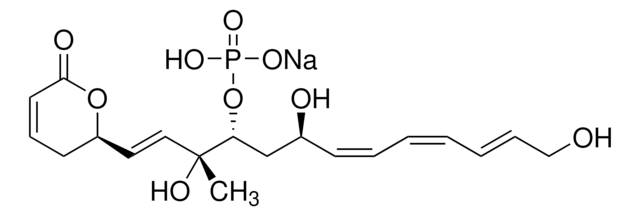O9381
Okadaic acid
from Prorocentrum concavum, 92-100% (HPLC), powder, protein phosphatase 1 inhibitor
Synonym(s):
OA
About This Item
Recommended Products
Product Name
Okadaic acid from Prorocentrum concavum, 92-100% (HPLC)
Quality Level
assay
92-100% (HPLC)
form
powder
solubility
DMSO: ≥1 mg/mL
ethanol: ≥1 mg/mL
methanol: ≥1 mg/mL
H2O: insoluble
storage temp.
−20°C
SMILES string
O[C@@H](C[C@@H]([C@@]1([H])O[C@@]2(CCCCO2)CC[C@H]1C)C)[C@]3([H])C([C@@H](O)[C@]4([H])O[C@]5(CC[C@@](/C=C/[C@@H](C)[C@@]6([H])O[C@]7(O[C@H](C[C@@](C)(O)C(O)=O)CC[C@H]7O)C=C(C)C6)([H])O5)CC[C@@]4([H])O3)=C
InChI
1S/C44H68O13/c1-25-21-34(55-44(23-25)35(46)12-11-31(54-44)24-41(6,50)40(48)49)26(2)9-10-30-14-18-43(53-30)19-15-33-39(57-43)36(47)29(5)38(52-33)32(45)22-28(4)37-27(3)13-17-42(56-37)16-7-8-20-51-42/h9-10,23,26-28,30-39,45-47,50H,5,7-8,11-22,24H2,1-4,6H3,(H,48,49)/b10-9+/t26-,27-,28+,30+,31+,32+,33-,34+,35-,36-,37+,38+,39-,41-,42+,43-,44-/m1/s1
InChI key
QNDVLZJODHBUFM-WFXQOWMNSA-N
Looking for similar products? Visit Product Comparison Guide
General description
Application
- to inhibit protein phosphatase 2 in spermatocytes culture
- to treat SH-SY5Y cells to prevent dephosphorylation to maintain tau
- to treat human embryonic kidney 293T cells (HEK293T) or H4 cells to analyse its effect on fused in sarcoma (FUS) protein
Biochem/physiol Actions
Features and Benefits
Preparation Note
signalword
Danger
hcodes
Hazard Classifications
Acute Tox. 3 Dermal - Acute Tox. 3 Inhalation - Acute Tox. 3 Oral - Skin Irrit. 2
Storage Class
6.1C - Combustible acute toxic Cat.3 / toxic compounds or compounds which causing chronic effects
wgk_germany
WGK 3
flash_point_f
Not applicable
flash_point_c
Not applicable
ppe
Eyeshields, Faceshields, Gloves, type P2 (EN 143) respirator cartridges
Choose from one of the most recent versions:
Already Own This Product?
Find documentation for the products that you have recently purchased in the Document Library.
Customers Also Viewed
Our team of scientists has experience in all areas of research including Life Science, Material Science, Chemical Synthesis, Chromatography, Analytical and many others.
Contact Technical Service











